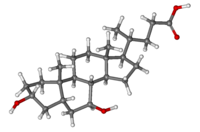
Photo from wikipedia
Cholesterol gallstone disease is a worldwide common disease. Cholesterol supersaturation in gallbladder bile is the prerequisite for its pathogenesis, while the mechanism is not completely understood. In this study, we… Click to show full abstract
Cholesterol gallstone disease is a worldwide common disease. Cholesterol supersaturation in gallbladder bile is the prerequisite for its pathogenesis, while the mechanism is not completely understood. In this study, we find enrichment of gut microbiota (especially Desulfovibrionales) in patients with gallstone disease. Fecal transplantation of gut microbiota from gallstone patients to gallstone-resistant strain of mice can induce gallstone formation. Carrying Desulfovibrionales is associated with enhanced cecal secondary bile acids production and increase of bile acid hydrophobicity facilitating intestinal cholesterol absorption. Meanwhile, the metabolic product of Desulfovibrionales , H 2 S increase and is shown to induce hepatic FXR and inhibit CYP7A1 expression. Mice carrying Desulfovibrionales present induction of hepatic expression of cholesterol transporters Abcg5/g8 to promote biliary secretion of cholesterol as well. Our study demonstrates the role of gut microbiota, Desulfovibrionales , as an environmental regulator contributing to gallstone formation through its influence on bile acid and cholesterol metabolism. Metabolic conditions associated with alterations of the gut microbiome, such as obesity and diabetes, predispose to gallstone disease. Here the authors demonstrate that the gut microbiome, in particular the genus Desulfovibrionale, contribute to gallstone formation in mice.
Journal Title: Nature Communications
Year Published: 2022
Link to full text (if available)
Share on Social Media: Sign Up to like & get
recommendations!